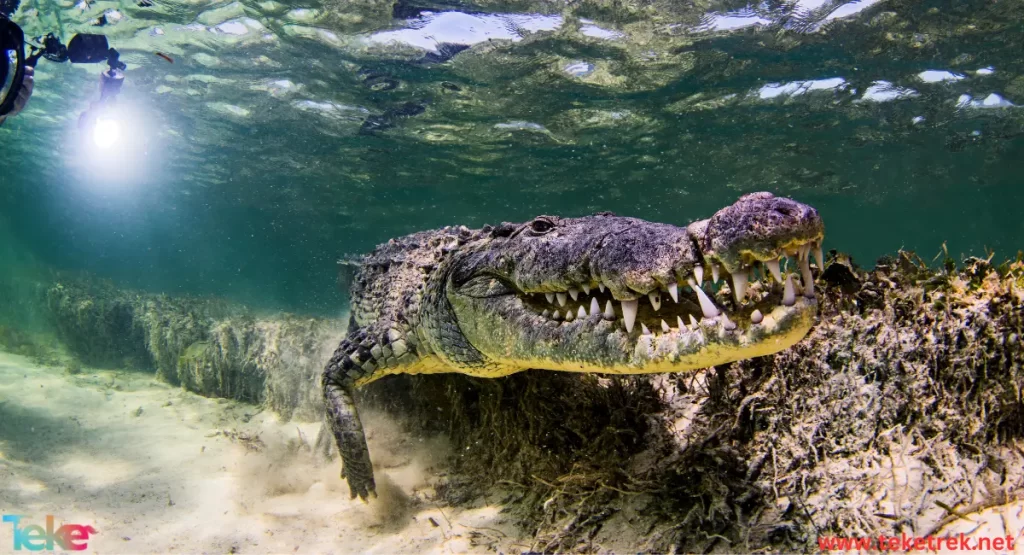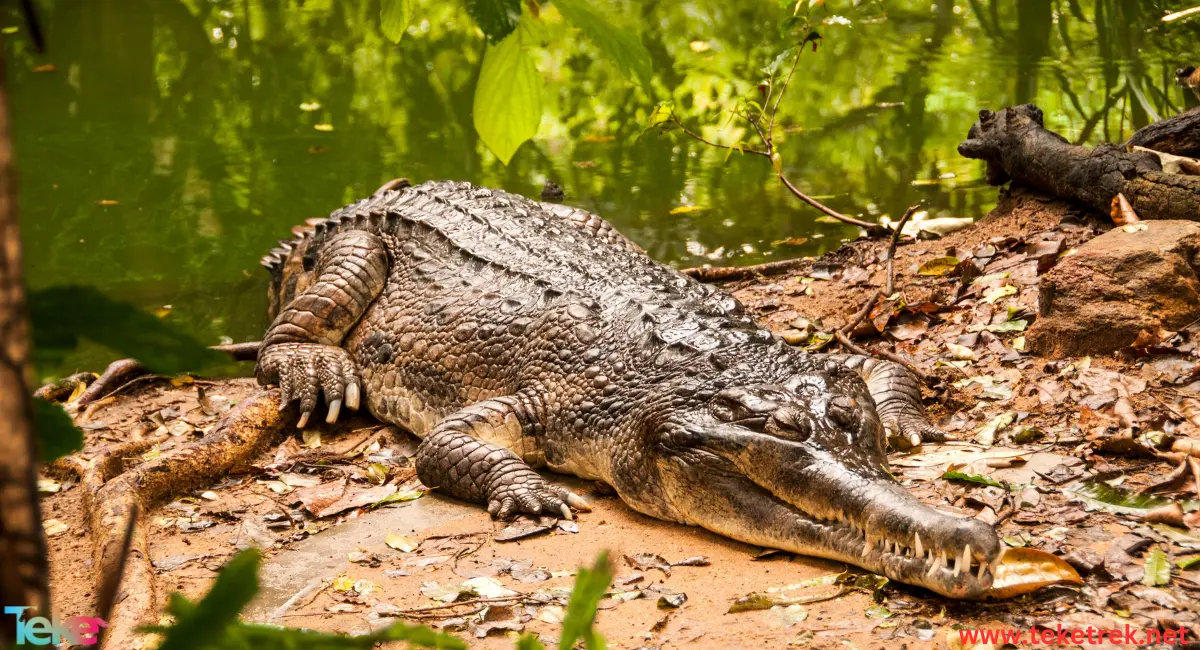The Cuban crocodile is one of the most prominent and distinctive types of crocodiles in the world, and it has received great attention from scientists researching the secrets of the animal world.
Its unique properties and distinctive appearance have been the subject of many studies, so let’s explore the details in today’s article from Teke Trek.

An introduction to Cuban crocodiles
At the beginning, we must point out that the distribution of the Cuban crocodile is restricted and does not spread widely, as we can find it in the Zapata Swamp in northwest Cuba and the Lanier Swamp on Juventud Island, whose total area is about 650 square kilometers.
Its unique properties and distinctive appearance have been fertile material for many studies
The Cuban crocodile is known by the scientific name (Crocodylus rhombifer), and it is classified as one of the types of reptiles that belong to the crocodile family and belong to the genus Alligator. The Cuban crocodile belongs to the phylum Omniformes, the phylum of vertebrates, from the class of reptiles.
It is also considered one of the rare animals threatened with extinction due to its exposure to many threats.
Cuban crocodile habitat
Scientists have indicated in their previous studies that there are traces indicating the spread of the Cuban crocodile previously in the Bahamas and the Cayman Islands. It is worth noting that the Cuban crocodile prefers to live in fresh water such as rivers, streams, lakes, ponds and river deltas. However, he rarely resorts to swimming in salt water.
What are the characteristics of the Cuban crocodile?
The Cuban crocodile, Crocodylus rhombifer, has unique characteristics that make it different and distinct from other types of crocodiles. Below we will point out its external structure and some of these characteristics:
The Cuban crocodile is a small and medium-sized creature, with males reaching a length of 3.5 metres, while females reach a length of 3 metres.
The typical Cuban crocodile weighs between 70 and 80 kg.
It has a short, broad head, as well as a bony ridge behind the eyes.
The Cuban crocodile has long, strong legs covered in horny armor that helps it walk on land over long distances.
It is known for its rough, pebbled scales, mixed with yellow and black.
It has a large bite force ranging between 1,392 and 3,127 Newtons, so it is considered one of the creatures that poses a danger to those around it.
The Cuban crocodile has a muscular neck, which allows it to raise its head higher than its back, and it also has a short nose.
The back of the Cuban crocodile consists of 6 longitudinal rows composed of a successive set of shields starting from 6 nuchal shields, which are thick and large in size.
When the Cuban crocodile wants to take a rest on the ground, it bends its hind limbs while keeping the front limbs extended.
The Cuban crocodile has very dark eyes, which makes it difficult to see the dark brown corner.
The Cuban crocodile has 68 strong, grooved teeth that help it crush the shells of the turtles it preys on.
The crocodile’s belly does not have any distinctive markings.
This crocodile has a tail with black stripes, which helps it travel and jump well.
The Cuban crocodile has scales extending from the dorsal carapace to the back of the neck.
The speed of the Cuban crocodile reaches 17 km per hour.
This crocodile can live between 50 and 75 years.
In addition to what we mentioned previously, the collective hunting behavior that the Cuban crocodile community is known for is one of its most important features. It is a hunting strategy invented by this species to prey on large animals.
Reproduction stages of the Cuban crocodile
The Cuban crocodile’s breeding season begins in May and usually lasts for 3-4 months. It digs or builds nests in the form of hills, knowing that this is related to environmental changes such as rain and temperatures.
30 to 40 eggs are produced and may reach 60 eggs, and this depends on the size and age of the mother.
It should be noted that not all of these eggs survive, as a result of several factors, including their exposure to predation by reptiles, birds, and mammals that devour the eggs and newly hatched crocodiles.
The size of Cuban crocodile eggs ranges between 5 and 7.6 cm, and their average weight is about 112 grams. They hatch after 58 to 70 days of laying.
The sex of the chicks can be determined by the temperature of the nest, as the internal temperature of the nest ranges between 30-32 degrees Celsius when the sex is male, while it is female when the temperature is higher or lower.
It should be noted that the Cuban crocodile is a polygamous animal.
Favorite food for Cuban crocodile
The young Cuban crocodile depends on its diet on crustaceans, freshwater arthropods and small fish, while the adult crocodile can prey on small mammals and turtles, thanks to its sharp teeth that help it crush turtle shells, in addition to dogs and wild boars.
This type of crocodile is distinguished by its jumping hunting method, as thanks to its strong tail, it can raise its body out of the water to pounce on small animals standing on tree branches extending above the water.
Many previous studies indicated that the Cuban crocodile was feeding on ground sloths, which are currently extinct animals.
Threats to the Cuban crocodile
The Cuban crocodile is considered an endangered animal. It has been listed by the International Union for Conservation of Nature on the list of critically endangered animals. The remaining number of it is between 3,000 and 6,000 mature crocodiles, and a set of effective measures have been taken to ensure its survival.
Perhaps the most prominent threats to the existence of the Cuban crocodile are excessive hunting in order to sell its meat and hybridization with the American crocodile, which led to a decrease in the preservation of its pure genes. In addition, information regarding its environment and biology is limited and fragmented, which hinders the implementation of reintroduction programmes.
Those interested in this matter have made many efforts to preserve the Cuban crocodile and increase its number, as the protection and breeding programs implemented since the sixties have allowed its numbers to increase slightly, and some of them have been bred in captivity in Europe and the United States, in addition to a zoo in India.

FAQs about the Cuban crocodile
Are Cuban crocodiles aggressive؟
Yes, it is a highly aggressive animal.
How fast is the Cuban crocodile?
It run From (15 to 22 miles) per hour.
How many Cuban crocodiles are left?
There are About 3000-6000 Cuban Crocodiles.
Do Cuban crocodiles eat humans?
Yes, Cuban crocodiles may attack humans.
In conclusion, the Cuban crocodile is a unique creature in terms of appearance, nutrition, reproduction and many other things. This animal is a wonderful addition to our natural world and an example that embodies the meanings of unity, strength and cooperation. Let us preserve it and strive with all possible efforts to preserve it and protect it from extinction.





